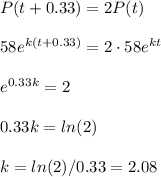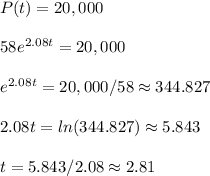
Mathematics, 14.07.2020 23:01 dajiaglosson
A common inhabitant of human intestines is the bacterium Escherichia coli. A cell of this bacterium in a nutrient-broth medium divides into two cells every 20 minutes. The initial population of a culture is 58 cells. (a) Find the relative growth rate. (Assume t is measured in hours.) k = (b) Find an expression for the number of cells after t hours. P(t) = (c) Find the number of cells after 8 hours. cells (d) Find the rate of growth after 8 hours. (Round your answer to three decimal places.) billion cells per hour (e) When will the population reach 20,000 cells? (Round your answer to two decimal places.) hr

Answers: 2
Another question on Mathematics


Mathematics, 21.06.2019 18:00
Polygon hh is a scaled copy of polygon gg using a scale factor of 1/4. polygon h's area is what fraction of polygon g's area?
Answers: 3

Mathematics, 21.06.2019 21:30
Which of the following shows the length of the third side, in inches, of the triangle below
Answers: 2

Mathematics, 21.06.2019 23:30
Which function represents the sequence? f(n)=n+3 f(n)=7n−4 f(n)=3n+7 f(n)=n+7
Answers: 1
You know the right answer?
A common inhabitant of human intestines is the bacterium Escherichia coli. A cell of this bacterium...
Questions

Physics, 20.02.2021 06:30




Health, 20.02.2021 06:40

Mathematics, 20.02.2021 06:40

Mathematics, 20.02.2021 06:40

English, 20.02.2021 06:40



Mathematics, 20.02.2021 06:40

Social Studies, 20.02.2021 06:40

Law, 20.02.2021 06:40



History, 20.02.2021 06:40

Geography, 20.02.2021 06:40

Biology, 20.02.2021 06:40

Computers and Technology, 20.02.2021 06:40







![dP/dt=58[2.08\cdot e^{2.08t}]=120.64e^2.08t=2.08P(t)](/tpl/images/0706/1207/c3631.png)




